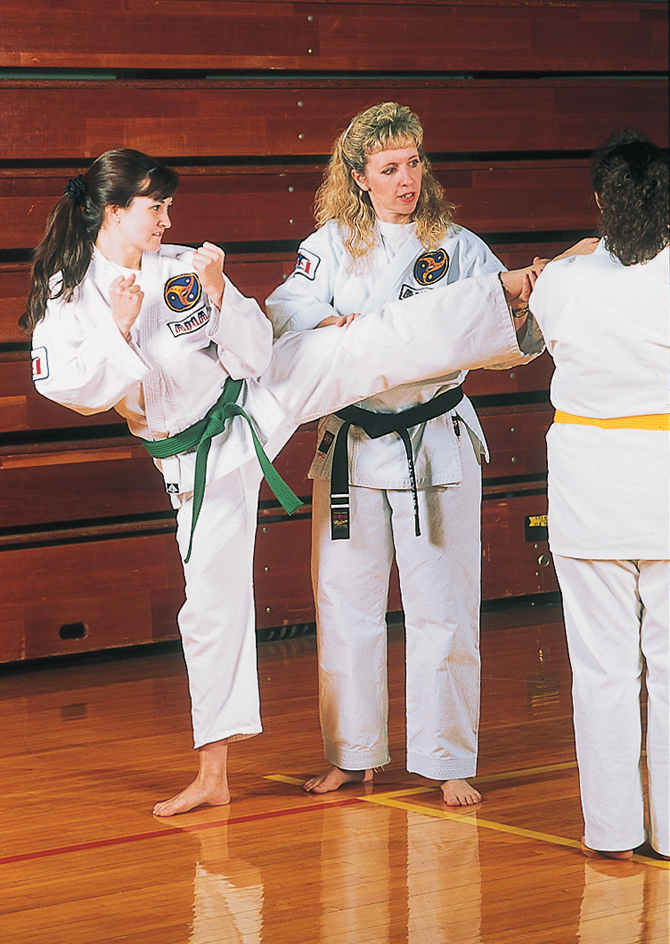Karate << kuh RAH tee or kuh rah TAY >> is a form of unarmed combat in which the competitor strikes with the hands, elbows, knees, or feet. Karate is one of the many forms of combat known as martial arts.

Karate developed on the island of Okinawa (now a part of Japan), but it has roots in the martial arts of southern China. Karate developed into its modern form during the late 1800’s. During the 1920’s and 1930’s, fans took karate from Okinawa to the Japanese mainland. Most terms used in karate are Japanese. After the end of World War II in 1945, interest in karate spread throughout the world.
Since the 1950’s, many books, motion pictures, and television shows have featured karate-style fights, further stimulating worldwide interest in this type of combat. A Korean martial art called taekwondo << ty kwahn DOH or teh gwahn DOH >> has many outward similarities to karate. Taekwondo became an official sport in the Summer Olympic Games in 2000. Karate was included as a sport at the 2020 Summer Olympic Games. The 2020 Summer Olympic Games were held in 2021 due to the COVID-19 pandemic.
Karate training.
A karate training hall is called a dojo << doh joh >> meaning place of the Way. Competitors wear uniforms that consist of loose cotton jackets tied with colored belts and trousers held up by either a drawstring or an elastic waistband. This uniform is called keikogi (practice wear), often shortened to gi. Competitors train in bare feet, but they may wear pads on their hands and feet during sparring.
Loading the player...Karate sounds
Karate rank is designated by colored belts. Beginners wear white belts. The most advanced competitors wear black belts. Most schools award different colors, such as green, purple, and brown, for intermediate ranks. Students earn promotions by demonstrating the techniques required for the next rank in front of one or more licensed examiners.
Karate training begins and ends with courtesy, represented by a series of bows that honor the style, the teacher, and the other competitor. After the beginning bows, there may be some breathing exercises. Next come physical exercises designed to strengthen and stretch muscles. Then competitors generally toughen their hands and feet by pounding padded boards or punching bags. Finally, they engage in drills with a partner, practice forms of movement, or spar with a partner.
Karate styles.
Each style of karate has its own stances and methods of blocking, kicking, punching, and striking. The English names for karate stances include back stance, cat stance, front forward stance, and horse stance. Common kicking techniques include the front kick, hook kick, roundhouse kick, and side kick. Punching in most styles involves hitting with the knuckles of the first two fingers, but competitors also use other parts of the hand. For example, striking with the edge of the open hand is called a knife-hand blow. Blocking methods depend on style. Some styles try to deflect an opponent’s attack, while others meet force with force.
After learning their basic stances, strikes, blocks, and kicks, students put them together using patterns called kata << KAH tah >> , which means form. Different styles teach different kata. The kata distinguish one karate style from another.
During sparring and kata, competitors sometimes give a yell called kiai << KEE eye >> , meaning blending of vital energy. Competitors use kiai to help them put maximum force into their technique. Kiai can also startle an opponent. The competitor produces the yell by expelling air from the lungs and tightening the stomach muscles.
Karate shows and exhibitions
often feature karate teachers and their students breaking various objects with their hands, feet, and head. However, most karate schools do not require students to break objects.
Blows to the head and groin are prohibited during tournaments, as are takedowns, throws, and joint locks. The amount of allowed physical contact varies. For example, some classes and styles teach competitors to stop just short of hitting. Others touch the partner only lightly. Still others allow considerable force to the body but no contact to the head. Participants should always understand how much contact the rules of a tournament allow before competing.
Classes and tournaments usually feature two types of graded contests, kata and kumite (free fighting). Tournaments use a referee, a timekeeper, and several corner judges. In a class, the instructor controls competition.
During kata competition, contestants demonstrate their form to a panel of judges. Each judge awards the contestants from 1 to 10 points, and the contestant with the highest total wins. During kumite, the contestants spar without prearranged techniques. A contestant scores when he or she delivers a blow that a majority of the judges consider effective.
